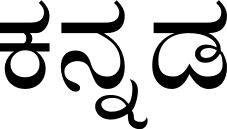Language/Kannada/Grammar/How-to-Use-Be
Hi Kannada learners! 😊
In this lesson, we will learn how to use the verb "be" in Kannada. "Be" is a special verb that is used to connect the subject of a sentence to its complement, which can either be a noun or an adjective.
To improve your Kannada grammar, you can also use the Polyglot Club website. Find native speakers and ask them any questions!
Present Tense[edit | edit source]
In Kannada, the present tense of the verb "be" is expressed differently depending on whether the subject is singular or plural:
| Kannada | Pronunciation | English |
|---|---|---|
| ನಾನು ಇರುವೆ | nānu iruve | I am |
| ನೀನು ಇರುವೆ | nīnu iruve | You are (singular) |
| ಅವರು/ಅವಳು ಇರುವರು/ಇರುವಳು | avaru/avalu iruvaru/iruvalu | He/She/It is |
| ನಾವು ಇರುವೆವು | nāvu iruvevu | We are |
| ನೀವು ಇರುವಿರಿ | nīvu iruviri | You are (plural) |
| ಅವರು/ಅವರೆಲ್ಲರೂ ಇರುವರು/ಇರುವಳು | avaru/avarellu iruvaru/iruvalu | They are |
Let's see some examples:
- Person 1: ನಾನು ಇರುವೆ. (nānu iruve.) (I am.)
- Person 2: ನೀನು ಯಾವ ವೃತ್ತಪತ್ರಿಕೆಯನ್ನು ಓದುತ್ತೀಯೆ? (nīnu yāva vṛttpatrikeyannu ōduttīye?) (Which newspaper are you reading?)
- Person 1: ಸಕಾಲದಲ್ಲಿ ನನಗೆ ಪ್ರತಿದಿನ ಪ್ರಾರ್ಥನೆ ಮಾಡಲು ಸಮಯವಿರುತ್ತದೆ. (sakāladalli nanage pratidina prārthanē māḍalu samayavirut-tade.) (I take time to say my prayers every morning.)
- Person 2: ಹಾಗೆ ಮಾಡುವುದು ಉಪಯುಕ್ತವಾಗುತ್ತದೆ. (hāge māḍuvudu upayukthavāgut-tade.) (It is useful to do so.)
Past Tense[edit | edit source]
To express the past tense of "be," we use the verb "ಆಗಿದ್ದೆ" (āgidde). Here is how it conjugates:
| Kannada | Pronunciation | English |
|---|---|---|
| ನನ್ನೂರು ವರುಷಗಳ ಹಿಂದೆ ನಾನು ಇರುವೆನೆಂದು ನೆನಪುಗಳು ನನ್ನನ್ನು ಪುನರ್ಜನ್ಮದಲ್ಲಿ ನೋಡುತ್ತವೆಂದು ತಿಳಿದು ಬರೆಯುತ್ತಾರೆ. | nannūru varuṣagaḷa hiṇḍe nānu iruvenendu nenapugaḷu nannannu punarjanmadalli nōḍuttavendu tiḷidu baryut-tāre. | Memories remind me that I existed in my past life. |
| ಅವರು ನಮ್ಮ ಸಂಢಯದ ಬಳಿ ಇದ್ದರು. | avaru namma sandhayada baṭi iddaru. | They were at our doorstep. |
Future Tense[edit | edit source]
To express the future tense of "be," we use the word "ಆಗುವುದು" (āguvudu). Here is how it conjugates:
| Kannada | Pronunciation | English |
|---|---|---|
| ಅವಳು ಸೆರೆ ಹಿಡಿದು ಬೀಳುವಳು. | avalu sare hiḍidu bīḷuvaḷu. | She will be in prison soon. |
| ನೀನು ಯಾವ ದಿನ ಬಂದು ನಮ್ಮಲ್ಲಿಗೆ ಬರುವಿ? | nīnu yāva dina bandu nammalliḍe baruvi? | When will you come to us? |
Negative Sentences[edit | edit source]
To make negative sentences, we add the word "ಅಲ್ಲ" (alla) after the verb. Here are some examples:
- ಅವಳು ಸೆರೆ ಹಿಡಿದು ಬೀಳುವಳು ಅಲ್ಲ. (avalu sare hiḍidu bīluvaḷu alla.) (She will not be in prison soon.)
- ನೀನು ಯಾವ ದಿನ ಬಂದು ನಮ್ಮಲ್ಲಿಗೆ ಬರುವುದಿಲ್ಲ. (nīnu yāva dina bandu nammalliḍe baruva- dill-a.) (You will not come to us.)
- ನಾನು ಕುಡಿಯುವುದಿಲ್ಲ. (nānu kuḍiyuvudilla.) (I am not drinking.)
Conclusion[edit | edit source]
In conclusion, using the verb "be" in Kannada is not difficult! With some practice and patience, you'll soon master it. Don't forget that the best way to learn a language is to practice it regularly, so find some friends to practice with on Polyglot Club!
➡ If you have any questions, please ask them in the comments section below.
➡ Feel free to edit this wiki page if you think it can be improved. 😎
Having concluded this lesson, consider checking out these related pages: 0 to A1 Course & Pronouns.
Other Lessons[edit | edit source]
- Give your Opinion
- How to Use Have
- Future Tense
- Questions
- Negation
- Conditional Mood
- Gender
- Adjectives
- Pronouns
Sources[edit | edit source]
- Kannada - Wikipedia
- Kannada Grammar Checker Using LSTM Neural Network | Semantic ...
- Kannada grammar - Wikipedia

